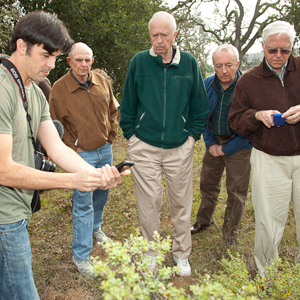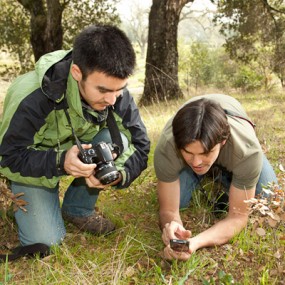Harnessing the power of “citizen science” can be a challenge, but many think technology can provide the missing link.

The new iPhone app for the online community iNaturalist is officially out and available for free download from Apple’s App Store. Its creator, Ken-ichi Ueda, hopes that the new app will make sharing and uploading field observations so easy, that more people will want to document what they find next time they’re out on a hike.
“My primary motivation is to get people outside, thinking about the plants and animals they are seeing and actually recording them,” he said. “The act of recording really locks it in your mind.”
But as I explain today in my radio piece on The California Report, Ueda and his partner Scott Loarie, a post-doctoral fellow at the Carnegie Institution, want to do more than just get people out in nature. They also are hoping that with the technology of iNaturalist, citizen scientists will collect and aggregate on-the-ground data that can be useful for scientists studying climate change.
“What we really want to do is to use a common social framework to connect local experts familiar with the biodiversity of a certain area to scientists who can make that data useful,” said Loarie.
For a quick how-to-lesson on using the app, check out this video:
While social networking and mobile technology may be fairly new, the basic idea of getting volunteers to help scientists document nature is not. In 1997, I volunteered on several occasions for NOAA’s SEALS program. We’d head out to Bolinas Lagoon in groups of three or four to stand by the side of Highway 1 for hours at a time counting seals. (We didn’t have iPhones then; just pencils, paper, and clipboards.) Then there’s the Audubon Society’s Christmas Day Bird Count, which just celebrated it’s 111th anniversary. More than 60,000 people across the county spend the holiday counting birds as part of that project.
There’s also the California Roadkill Observation System, a project of UC Davis that asks volunteers to report roadkill sitings. Organizers hope to use the data to identify and predict “roadkill hot-spots.”
There are actually dozens (at least) of ways to get involved with citizen science efforts around the state. And if animals (and roadkill) aren’t your thing, there are efforts like Mushroom Observer. Project Budburst, and the Great Sunflower Project. Many more are listed on the Science for Citizens website, which lets you search projects by topic, location, and difficulty.
2 thoughts on “Connecting Citizens and Science… with Smart Phones”
Comments are closed.


To download the app iPhone users should go to the app store and search for iNaturalist.
This is great information for ENVIRONMENTAL WELLNESS – WHICH INCLUDES THE SKY. This is a great application to monitor chem trails/geoengineering. check out the videos already on You Tube and be shocked at the aerosol spraying already going on and with what unintended consequences and by whose authorization is life on the planet being sprayed!!!